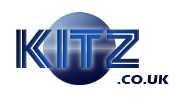|
Telephone (POTS) Equipment
|
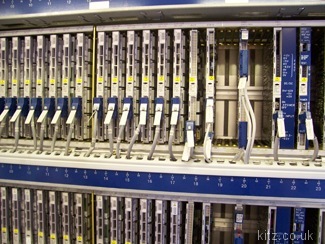
|
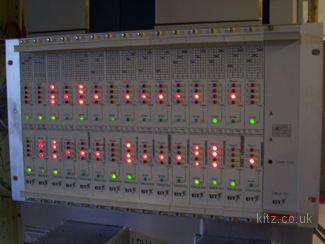
|
Telephone Line Cards
Distinct 'clicking' can be heard when a line rings.
|
DACS Unit
Digital Access Carrier System
|
| |
|
ADSL Equipment
|
Main Distribution Frame (MDF)
|
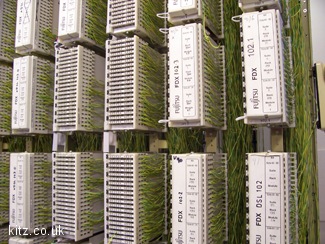
|
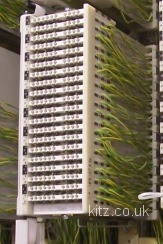
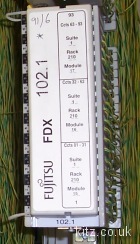
|
|
Main Distribution Frame
(MDF)
|
MDF - ADSL Panel Blocks
|
The MDF is where every telephone line copper pair terminates at the exchange. Photos show exchange side of the MDF, whilst at the back is called the Distribution side.
This side shows which lines have adsl and each panel group(s) relate to a particular DSLAM. It is here that if you move to a different DSLAM or on to LLU that you line will be moved by an BT Frames Engineer.
|
ADSL Line Cards
|
|
From the MDF panel, your line will go to an ADSL line card, each line card ties up and labeled according to the MDF panel which your line is attached to. Line cards form part of the DSLAM.
Here you can see the line in as it passes through the DSLAM line card at the top and back out again at the bottom back to the POTS.
The smaller grey (CAT 5 cable) leads is the IML cable which carries the ADSL data to the DSL Switch Hub.
Different types of line cards are in use at the exchange, and depending upon the type and model of the line card can hold different numbers of subscribers.
The currently most modern line cards are those in use by MSANs or Fujitsu IV-LCSS which can hold 64 subscribers per line card. Fujitsu IV-LCSS line cards in conjunction with Fujitsu Geo-stream kit will be used in many exchanges for 21CN. Note: BT has been using IV-LCSS line cards for a while in some non 21CN exchanges. |
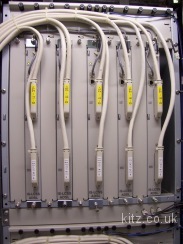
ADSL line cards
(Fujitsu IS-LCSS)
|
DSLAM
|
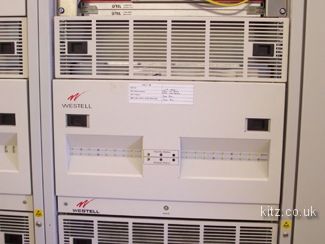
|
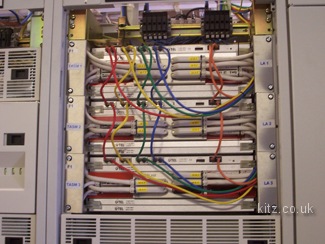
|
Early DSLAMs
Installed in many exchanges
|
1st Generation DSLAM
Inter spaced with UTEL TASMs
|

|
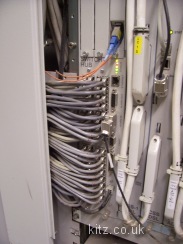
|
Fujitsu FDX Master Control Shelf
(This DLSAM is using Fujitsu LCSS-1 Line cards)
|
Fujitsu DSL Switch Hub
This particular switch has connections from 64 line cards. At the top you can see
STM-1 (155Mb) optical fibre link.
|
Fujitsu GeoStream DSLAM/MSANs
|
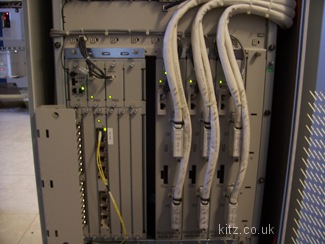
Fujitsu GeoStream Access Gateway
The Hub on the left can be responsible for several dslams and/or sub exchanges.
This particular hub shown currently supports 32 line cards, but the IML can be further extended in blocks of 32.
Depending on exchange requirements/21CN it can be fitted with Hub 64 or Hub 1000 switches.
Hub 64 used in conjunction with IV-LCSS-64 can support up to 2048 users and is already in use in some exchanges.
Hub 1000 for 21CN can support more than 10,000 lines. The Hub 1000 GeoStream is a leading Multi Service Access Node for 21 Century Networks - link
Note the NIM unit (where the yellow cable is plugged in) which can be used for E3/STM-1/STM-4 rather than STM-1 module previously used on older dslams. |
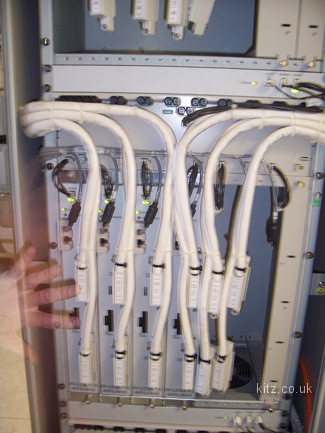
Fujitsu Geostream
IV-LCSS Line cards.
These Integrated Voice and Data line cards handle 64 subscriber lines per unit and can be remotely controlled.
|
|
MSANs
Multi Service Access Nodes - Used in many BT exchanges for ADSL Max and by LLU suppliers.
BT Wholesale tend to
use Marconi MSANs for maxdsl although LLU providers may choose other MSAN manufacturers, for eg CPW tend to use Huawei. The Marconi MSANs can support up to 2,400 subscribers (2 x 1,200 DSL lines per shelf, each shelf comprising of 20 x 60 channel adsl2/2+ line cards).
BT announced that it will be using Fujitsu GeoStream kit for 21CN, but there are also some Huawei MSANs in use.
|
|
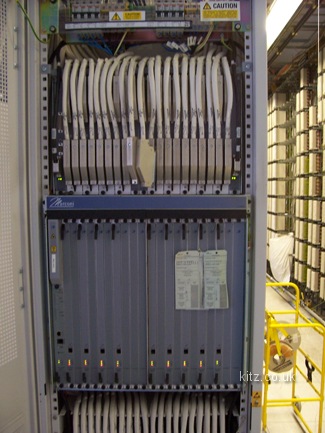
Marconi MSANs
|
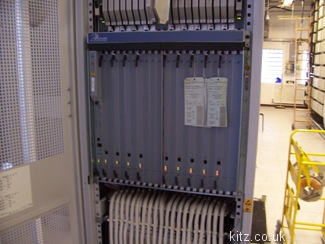 |
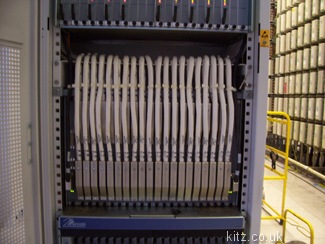 |
LLU Handover Frames
|
Local Loop Unbundling (LLU) is where an ISP or CP installs their own equipment in the local exchange. There are 2 types of LLU:
- MPF (Full Metallic Path Facilities)
ISP provides both broadband and telephone/voice services over their own network
- SMPF (Shared Metallic Path Facilities)
ISP provides broadband only. Voice services are provided by an alternative network (eg BT).
Each LLU provider that has a presence in the local exchange will have its own Hand Over Distribution Frame which is located near to their MSAN. This frame may also be known as a High Density Frame (HDF) and is the demarcation point of the BT network.
~ The picture on the right shows the front of a Hand Over Frame for a SMPF LLU provider,
~ Below shows the reverse of a newly wired Hand Over Frame. |

|
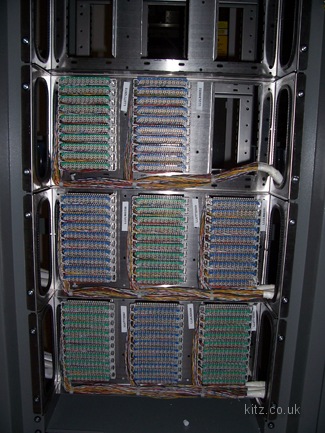
LLUT Modules are Green - Exchange side - LLU Tie
LLUL Modules are Blue - LLU Line sharing
LLUC = LLU Co-mingling |
With LLU the copper pair will enter the exchange as normal on to the MDF.
However,
LLU lines will have their own designated Panel blocks on the MDF which are attached to the HDF via a tie cable containing 100 pairs.
In this picture you can see the thick white tie cables from the MDF Block entering the reverse side of the handover frame from the right.
Each individual pair is then attached to HDMCCS modules (High Density Modular Cross Connect) using IDC connectors and then onwards to the LLU MSANs line cards.
It is at the Hand Over Frame that the difference between SMPF and MPF providers becomes visibly apparent.
With MPF LLU both adsl & voice data traverses the LLU operators network and therefore lines provisioned as full MPF only need LLUT tie cables to send data between LLUT Blocks on the Handover frame and the MDF.
> Home
> MDF
> LLUT
> MSAN (dsl + voice) ->> ISP/CP backhaul
With SMPF all data traverses LLUT ties and modules towards the LLU MSAN. Splitters on the Integrated line cards separate the traffic so that dsl data is processed via the MSAN to the ISP backhaul. Voice traffic which has been filtered is passed via LLUL Module Blocks & LLUL tie cables over to BTs POTS equipment.
> Home
> MDF
> LLUT
> Splitter separates voice -> and dsl frequencies >>
>> MSAN
(dsl) >> backhaul >> ISP
-> LLUL
-> POTS (voice) -> BT /WLR eg
|
| |
|
Fibre Optic Backhaul
|
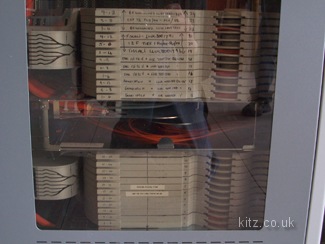
|
Optical Fibre Distribution Frame Cabinet
BT Wholesale Fiber Tie Trays on the bottom shelf.
LLU providers on the top shelf.
This particular exchange has
5 LLU Operators and MSANs.
| Backhaul Provider |
ISP MSAN |
| Be Unlimited |
Be / O2 |
| Tiscali Wholesale |
Tiscali + various |
| Opal |
AOL |
| Opal |
TalkTalk |
| Easynet |
UKO / Sky |
Closer inspection reveals Fibre from both the AOL and TalkTalk MSANs being fed into the same tray. |
| |
|
TAM (Test Access Matrix)
|
|
U-tel TAM equipment.
ADSL diagnostic equipment that can be accessed remotely to help diagnose broadband faults. A suite of tests are available to the ISP/adsl engineer.
Photo shows Test Access Switch, Switch Matrix Controller and various switch modules (TASMs) and auxiliary cards |
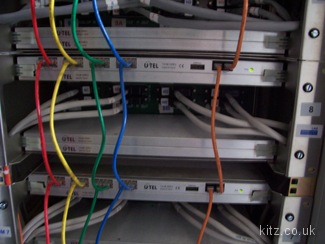 |
|
|
|
